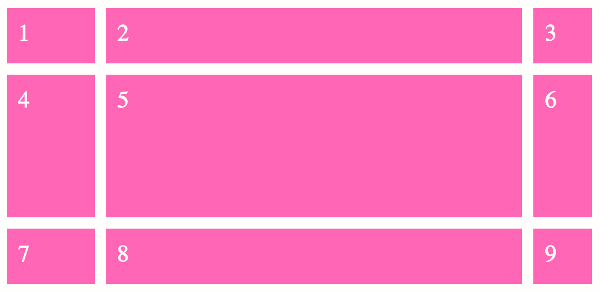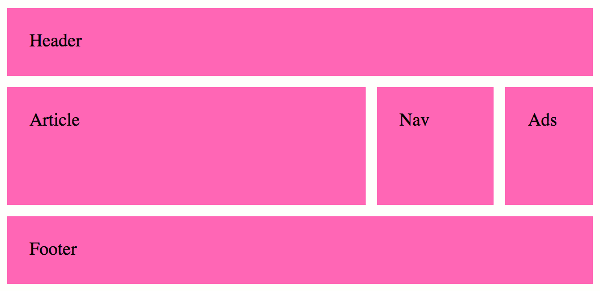CSS grid-template
The CSS grid-template property is a shorthand property for setting the grid tracks and named grid areas.
If your browser supports CSS grids, the above example should look like this:

The grid-template property sets the grid-template-rows, grid-template-columns, and grid-template-areas properties. This can be a convenient way to set those properties without having to type out each property name.
Here's an explanation of how grid-template is used in the above example.
The grid-template property sets the rows and columns, separated by a forward slash. In this example the first row is 20vh, the second is 1fr, and the third is 20vh. The first column is 15vw, the second column is 1fr, and the third column is 10vw.
The vh and vw units are length units that represent 1% of the viewport's height (for vh) or width (for vw).
The fr unit represents a fraction of the free space in the grid container. It is referred to as a flexible length or simply flex.
Using the "ASCII art" Syntax
The grid-template-areas property allows you to define the template areas using a kind of "ASCII art" syntax. This makes it extremely easy to visualize your grid, as the ASCII art represents exactly how the grid is laid out.
Seeing as grid-template-areas is one of the properties covered by the grid-template property, you can provide the ASCII art straight to the grid-template property.
The way it works is, you create a text-based grid using named grid areas. If a grid area is wider or taller than others, you simply repeat that name across (or down) the grid.
The named grid areas are provided as a series of strings, each one representing a different row.
Like this:
Here's a working example:
The above code results in the following grid:

Named Lines
You can also modify the above example to use named lines, like this:
Named lines can make the grid easier to understand, as you can provide meaningful names to all of the lines in the grid.
Named lines can be either explicit or implicit.
-
Explicit named lines are where you provide the names. These can be specified as part of the
grid-template-rowsandgrid-template-columnsproperties (which are both covered by thegrid-templateshorthand property). -
Implicit named lines are names that are automatically created from the
grid-template-areasproperty. These named lines are created from the named grid areas in the template.For each named grid area named foo, four implicit named lines are created. Two named
foo-startname the row-start and column-start lines of the named grid area, and two namedfoo-endname the row-end and column-end lines of the named grid area.
Named lines are specified using a custom-ident value (a user defined identifier).
Syntax
Here's the official syntax of the grid-template property:
Where
Possible Values
none- Sets all three properties to their initial values (
none). - 'grid-template-rows' / 'grid-template-columns'
-
Sets the
grid-template-rowsandgrid-template-columnsproperties to the specified values, and sets thegrid-template-areasproperty tonone. - [ line-names? string track-size? line-names? ]+ [ / explicit-track-list ]?
-
This syntax allows you to specify the line names, track sizes, and grid areas within the respective lines. Like this:
The line-names can be specified by using a custom-ident value.
The string specifies the named grid areas.
The track-size specifies the size of the track.
In addition, all CSS properties also accept the following CSS-wide keyword values as the sole component of their property value:
initial- Represents the value specified as the property's initial value.
inherit- Represents the computed value of the property on the element's parent.
unset- This value acts as either
inheritorinitial, depending on whether the property is inherited or not. In other words, it sets all properties to their parent value if they are inheritable or to their initial value if not inheritable.
Basic Property Information
- Initial Value
- As each of the properties of the shorthand. These are:
grid-template-rows:nonegrid-template-columns:nonegrid-template-areas:none
- Applies To
- Grid containers
- Inherited?
- No (i.e. none of the shorthand properties are inherited)
- Media
- Visual
- Animation type
- Discrete (see example)
CSS Specifications
- The
grid-templateproperty is defined in CSS Grid Layout Module Level 1 (W3C Candidate Recommendation, 9 February 2017).
Browser Support
The following table provided by Caniuse.com shows the level of browser support for this feature.
Vendor Prefixes
For maximum browser compatibility many web developers add browser-specific properties by using extensions such as -webkit- for Safari, Google Chrome, and Opera (newer versions), -ms- for Internet Explorer, -moz- for Firefox, -o- for older versions of Opera etc. As with any CSS property, if a browser doesn't support a proprietary extension, it will simply ignore it.
This practice is not recommended by the W3C, however in many cases, the only way you can test a property is to include the CSS extension that is compatible with your browser.
The major browser manufacturers generally strive to adhere to the W3C specifications, and when they support a non-prefixed property, they typically remove the prefixed version. Also, W3C advises vendors to remove their prefixes for properties that reach Candidate Recommendation status.
Many developers use Autoprefixer, which is a postprocessor for CSS. Autoprefixer automatically adds vendor prefixes to your CSS so that you don't need to. It also removes old, unnecessary prefixes from your CSS.
You can also use Autoprefixer with preprocessors such as Less and Sass.